Home | Airshows | The Hangar | Nostalgia | Links
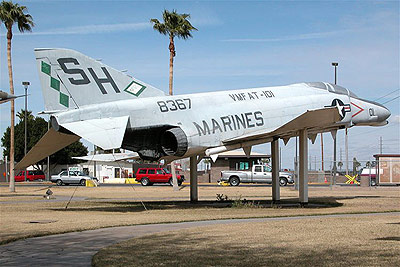 Winter
Sunů
Winter
Sunů
Tom McGhee takes a trip to the USA to find some...Part one of two
During the depths of a British winter with no sign of sunlight for weeks on end, thoughts turn to far off airfields and sun drenched jets.
So, spurred on by a recent plummeting of the value of the US dollar compared to sterling, plans hatch to visit a desert area in the south-west of the USA. A check also reveals that one of the earliest airshows of the year is held in late February in Arizona, and an outline trip soon makes itself clear. With non-stop return flights to Phoenix at well under £300 including all taxes, as well as the supremely advantageous currency exchange rate, this seemed too good an opportunity to miss.
So, it is late February and four intrepid travellers set off from a cool and clear Heathrow airport for a ten-hour flight to Phoenix, Arizona. The latest security methods in place haven't seemed to delay immigration any more than normal, as there now appears to be considerably more immigration staff on duty to process all the arriving passengers into the USA. After arrival we collected our four-wheel drive SUV (this possibly seems a bit of overkill, but we were extremely glad to have had it after some of our subsequent off-road adventuring) then had time to check out Sky Harbor Airport before heading to our 'luxurious' accommodation.
Day breaks on our first full day in Phoenix, a city with more than its fair share of airports. Following a brief visit to Glendale and Luke AFB (adequately described by other correspondents and elsewhere), we get to Deer Valley for breakfast, and a visit round the ramp of Worldwide Warbirds Inc. This organisation operates and sells a number of Czech-built Aero L-39 Albatroses, obtained from a variety of sources, and many of these aircraft are in pristine condition, having been reworked by Aerostar in Romania.
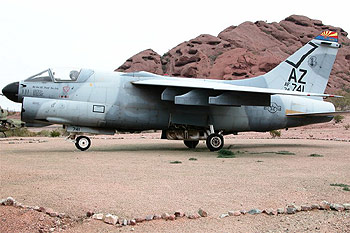 One
of the lesser-known airfields in Phoenix is the Arizona National Guard
base at Papago AAF. This houses a number of UH-60 Blackhawk and OH-58
Kiowa helicopters, and also has a museum which is home to a UH-1 Iroquois.
The preserved A-7D Corsair II on the main gate sports the ubiquitous Arizona
State Flag marking on the fin tip, as do almost all other Arizona Army
and Air National Guard aircraft.
One
of the lesser-known airfields in Phoenix is the Arizona National Guard
base at Papago AAF. This houses a number of UH-60 Blackhawk and OH-58
Kiowa helicopters, and also has a museum which is home to a UH-1 Iroquois.
The preserved A-7D Corsair II on the main gate sports the ubiquitous Arizona
State Flag marking on the fin tip, as do almost all other Arizona Army
and Air National Guard aircraft.
Mesa Falcon Field is a former RAF airfield that was used to train British aircrew during the Second World War. Today, as well as where Boeing Helicopters produce and rebuild AH-64 Apaches, there are many other residents here. Marsh Aviation produces Fire Bombing Trackers for use by the US Forestry Department - these aircraft are converted from old Grumman S-2 Trackers, once operated by the US Navy and Japan. The conversion of these veteran anti-submarine warplanes into a life saving fire-fighting aircraft involves a major strip down and rebuild, new engines, and new paint scheme. It is great to see these aircraft finding such a valuable new lease of life.
The Arizona Wing of the Commemorative Air Force operates a number of flyable warbirds from here, as well as displaying some excellently preserved aircraft in their museum. The immaculate McDonnell Douglas F-4N Phantom II 153016 is displayed in US Navy marks operating from USS Ranger.
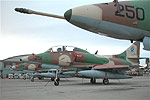 Williams
Gateway is a former USAF training base, and is a popular location for
visiting aircrews. Boeing has a facility here to re-work USAF Northrop
T-38 Talons, but the most recent new activity here centres on the operations
of Advanced Training Systems International Inc. (ATIS) with their A-4
Skyhawks. There is a growing need for fast jet training and adversary
training for US and allied crews following recent downsizing in US forces
which meant the disbanding of the Aggressor units and suchlike. ATIS was
formed to fulfil this type of requirement and is run by highly experienced
personnel including Vietnam veterans and astronauts. A fleet of former
Israeli Defence
Williams
Gateway is a former USAF training base, and is a popular location for
visiting aircrews. Boeing has a facility here to re-work USAF Northrop
T-38 Talons, but the most recent new activity here centres on the operations
of Advanced Training Systems International Inc. (ATIS) with their A-4
Skyhawks. There is a growing need for fast jet training and adversary
training for US and allied crews following recent downsizing in US forces
which meant the disbanding of the Aggressor units and suchlike. ATIS was
formed to fulfil this type of requirement and is run by highly experienced
personnel including Vietnam veterans and astronauts. A fleet of former
Israeli Defence 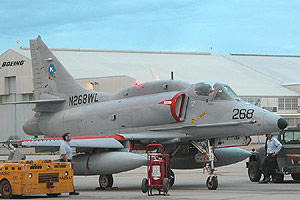 Force
TA-4J and A-4Ns are used to provide the training; many of them still retain
their Israeli desert camouflage scheme. These colours will gradually be
replaced with the grey scheme which is already carried by some as they
go through their major maintenance schedule. Williams was chosen for its
three long runways and excellent weather which means that an almost unlimited
number of sorties can be flown from here if required.
Force
TA-4J and A-4Ns are used to provide the training; many of them still retain
their Israeli desert camouflage scheme. These colours will gradually be
replaced with the grey scheme which is already carried by some as they
go through their major maintenance schedule. Williams was chosen for its
three long runways and excellent weather which means that an almost unlimited
number of sorties can be flown from here if required.
And so, the end of our first full day in Arizona, with a drive across the state for the Marine Corps airshow at Yuma scheduled for the next day.
|
Yuma
yummies
|
 |
 |
 |
 |
 |
 |
 |
 |
 |
 |
 |
Yuma MCAS Airshow and Open House, 21 February 2004
Yuma is situated in the extreme South West corner of Arizona, close to California near the Mexican border. The US Marine Corps has long had a presence in this arid desert location, with their airmen taking advantage of the superb weather conditions and clear skies.
The annual airshow and Open House here is traditionally held at the end of February as the temperatures in this region during the height of summer can be quite sapping. In common with many Arizona (and elsewhere) airfields, sun shades have been erected on the operating dispersals to protect both the ground crews and the delicate electronics systems on the aircraft from overheating. These sun shades pose some problems for photographers though, as the aircraft are now surrounded by the metal framework of girders and cables and struts, plus there is almost always a highly defined shadow edge cast on the airframe between sunlight and shade.
As an airshow, Yuma follows the pattern typical of many US shows. What we in Europe would consider to be a 'lightweight' flying display schedule is further hampered here by the fact that Yuma is also a busy airport with constant movements of commuter aircraft, which the flying display has to be co-ordinated with.
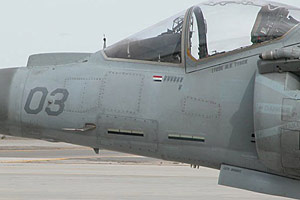 As
well as an adversary F-5E unit and a base flight, four attack squadrons
equipped with BAe/McDD AV-8B and AV-8B+ Harrier IIs fly from Yuma, some
having recently returned from combat operations over Iraq. Harriers are
much sought after in the Middle East and Afghanistan due to their ability
to carry a large amount of weapons from rough and semi-prepared airstrips
closer to the frontline, rather than thousands of feet of well maintained
runways well away from the battlefield.
As
well as an adversary F-5E unit and a base flight, four attack squadrons
equipped with BAe/McDD AV-8B and AV-8B+ Harrier IIs fly from Yuma, some
having recently returned from combat operations over Iraq. Harriers are
much sought after in the Middle East and Afghanistan due to their ability
to carry a large amount of weapons from rough and semi-prepared airstrips
closer to the frontline, rather than thousands of feet of well maintained
runways well away from the battlefield.
A lack of crowd barriers around the static aircraft is the norm in the USA, great for the punters to get up close to see what their tax dollar is going on, but can be quite a problem for some photographers (especially some of the less patient continental types!). On the subject of static aircraft, the local squadrons paraded a Northrop F-5E, Beech UC-12B and a Bell HH-1N; however there was an alarming scarcity of based Harriers, with only a single resident VMA-513 AV-8B on show along with a visiting VMAT-203 TAV-8B. A pair of based VMA-513 AV-8Bs was on the flightline ready to perform in the flying display, but that seemed a pretty poor turnout of the home side.
For us though, it was not necessarily the quantity of aircraft on show, or even the quality or proximity of the flying displays that attracted us, it was the variety of unusual types and units that were on show, coupled with the cloudless skies and very reasonable entrance fees ($0 each!) which made the day for us. The highlights of the static park were those types which are rarely seen on our side of the Atlantic, the USCG HH-60, US Navy Goshawk, and NASA F-18 were amongst the rarest examples.
After the usual amble through the static park and beneath the annoyingly unoccupied sun shades, an obligatory burger was obtained. It was at this point we noticed that the far end of the flightline did indeed contain numerous more Harriers, as well as all the other flying display aircraft. Apparently the based aircraft vacated their sun shades to move on to the visitors' ramp, making way for the airshow paraphernalia, so with a spring in our step we proceeded on to make the best of a great opportunity. We were in luck, because alongside the based Harriers was a detachment of visiting AV-8Bs and TAV-8Bs from VMAT-203 at Cherry Point, who were at Yuma making use of the nearby Barry M. Goldwater bombing ranges. These ranges cover 2.7 million acres and incorporate four dummy target airfields, various convoys, staging areas and other targets.
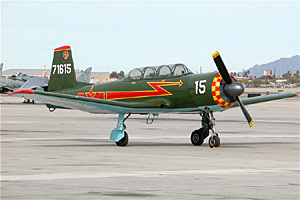 Other
flying display aircraft included the West Coast A-10 demo, as recently
seen in Europe but this time using their normal 355 Wing aircraft from
Davis Monthan. The US Army parachute team 'Golden Knights' also performed,
using their normal C-31A as opposed to the C-141B Starlifter they jumped
from when they were last at Mildenhall. An interesting warbird type which
is becoming more common in the USA is the Chinese built Nanchang CJ-6,
with no less than five of these present during the day.
Other
flying display aircraft included the West Coast A-10 demo, as recently
seen in Europe but this time using their normal 355 Wing aircraft from
Davis Monthan. The US Army parachute team 'Golden Knights' also performed,
using their normal C-31A as opposed to the C-141B Starlifter they jumped
from when they were last at Mildenhall. An interesting warbird type which
is becoming more common in the USA is the Chinese built Nanchang CJ-6,
with no less than five of these present during the day.
Overall verdict, a small show but with some interesting types, good weather and a great way to dust off the camera and get rid of those winter blues.
Home | Airshows | The Hangar | Nostalgia | Links